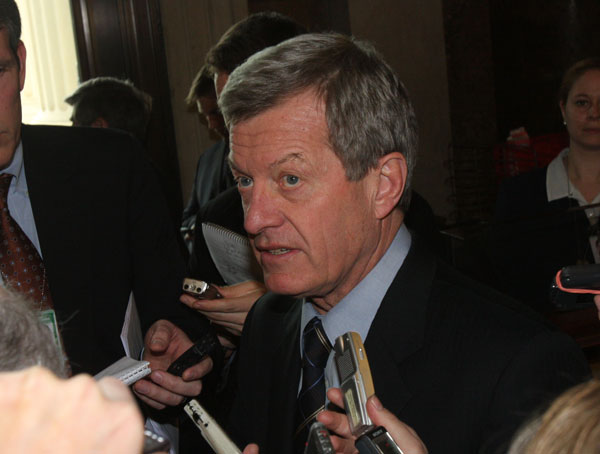Medicaid Expansion Would Guarantee Coverage, Not Care
A central component of Democrats’ health care reform plans would bring more people under the umbrella of coverage, but less clear is whether more patients would find treatment.
Jul 31, 202018.6K Shares644.5K Views
Sen. Max Baucus (D-Mont.)(WDCpix)
Millions of uninsured low-income Americans, poised to gain coverageunder the Democrats’ plans to expand Medicaid eligibility, won’t necessarily be guaranteed careunless more providers agree to participate in the program, a number of doctors, health policy experts and consumer groups are warning this month. The access issue is sure to be a thorn in the side of congressional leaders, who at once want to expand coverage to millions of uninsured folks while also reining in skyrocketing health care costs.
As a central component of the Democrats’ health reform strategy, party leaders in both chambers have proposed a broad expansion of Medicaid, the federal-state partnership that covers the poorest Americans. But less than half the nation’s physicians accept all new Medicaid patients, according to recent surveys. Unless Congress takes steps to encourage more doctors to participate in the program, many experts caution, the expansion could leave the nation’s most vulnerable folks with new coverage but without access to health services. The specter has left many in the healthcare community asking, What good is insurance coverage if local doctors don’t accept it?
Illustration by: Matt Mahurin
“This is not really an issue of insurance coverage,” Mel Stern, a Maryland-based pediatrician, told House lawmakers last week. “This is an issue of access to quality health care.”
A series of recent studies lay out the problem. Medicaid payments, despite a 15 percent increase between 2003 and 2008, represent just 72 percent of what Medicare pays for the same services, researchers at the Urban Institute reported in April.
As a result of the low payments — among other factors — physicians have been reluctant to participate in the Medicaid program. Only about 40 percent of physicians accept all new Medicaid patients, versus 58 percent for Medicare patients, according to a September studyfrom the Center for Studying Health System Change, which randomly surveyed more than 4,700 physicians. And that number drops to about 31 percent among family doctors and general practitioners. About 28 percent of all physicians don’t accept any new Medicaid patients at all, the group found.
For dentists, the numbers are even more dismal. A 2007 survey by the American Dental Association found that fewer than 27 percent of respondents treated Medicaid-insured patients.
That reluctance of many health care providers to accept new Medicaid patients can have tragic consequences. In a high-profile 2007 case, a Maryland boy named Deamonte Driver died from an abscessed tooth that spread bacteria to his brain. He had Medicaid but his family struggled to find a dentist who accepted it. He was 12 years old.
“Almost overwhelmingly, these low payment rates are causing real problems,” said William Vaughan, senior policy analyst at Consumers Union.
Not that lawmakers aren’t aware of those problems. A health reform billmaking its way through the House not only hikes Medicaid eligibility from 100 percent to 133 percent of poverty, it also aims to encourage greater physician participation by bumping Medicaid reimbursements for primary care services to match Medicare rates in 2012 and beyond. The Congressional Budget Office estimatesthe proposal would provide 11 million uninsured Americans with Medicaid coverage at a cost of $438 billion over 10 years.
Rep. Elijah Cummings (D-Md.) said Democrats are hopeful the change would “prompt doctors who take neither Medicaid nor Medicare to begin accepting both, since patient totals will improve.”
But the provision is by no means assured passage. Indeed, on Tuesday the Senate Finance Committee began marking up a health reform proposal of its own — a bill absent the Medicare matching rate provision.
An amendment proposed by Sen. Charles Grassley (Iowa), senior Republican on the finance panel, would require states to hike Medicaid rates to equal those of Medicare beginning in 2014. But Grassley is proposing to pay for his provision by eliminating federal subsidies proposed to help a wealthier group of uninsured Americans: families living between 300 percent and 400 percent of poverty. That strategy, according to Jocelyn Guyer, co-executive director at Georgetown University’s Center for Children and Families, is a controversial one that puts the underlying Medicaid proposal at risk of dying an early death in the committee.
Another GOP amendment, offered by Sen. John Cornyn (Texas), aims to gut the Democrats’ Medicaid expansion altogether by requiring White House health officials first to “certify that at least 75 percent of physicians in the country accept Medicaid patients.” Although it’s entitled “Ensuring Medicaid beneficiaries have access to a doctor,” Cornyn’s amendment would provide no money to do so.
There are other concerns. While the original House bill required the federal government to pick up 100 percent of the Medicaid pay increases for primary care services, an amendment attached by the Blue Dog Democrats during the Energy and Commerce Committee markup would return 10 percent of the cost burden back to the states in 2015. Already reeling from the budget pressures that accompanied the recent economic downturn, many states are in no mood to absorb further costs, even in the name of getting more care for low-income residents, according to Ann Kohler, director of the National Association of State Medicaid Directors. As a result, Kohler said, NASMD isn’t putting its weight behind the proposal to hike Medicaid payments to physicians.
There are other barriers to Medicaid patients getting care as well. Kohler also warned that higher payments alone won’t guarantee that physicians will begin accepting more Medicaid patients. Other factors, like a relatively high rate of Medicaid patients breaking appointments, she said, can also affect providers’ decisions. A December 2008 study foundthat bureaucratic hassles surrounding Medicaid claims also discourage doctors from accepting patients covered under the program.
Still, many policy experts maintain that Medicaid remains the best program for the nation’s lowest-income population. Edwin Park, health policy analyst at the Center on Budget and Policy Priorities, said Medicaid is most appropriate because the cost to patients is minimal and it provides the type of comprehensive care catering to the special needs of that population, which tends to be sicker than other demographic groups.
But the Medicaid program “does have flaws,” Park added, “and access is one of them.”

Paula M. Graham
Reviewer
Latest Articles
Popular Articles

